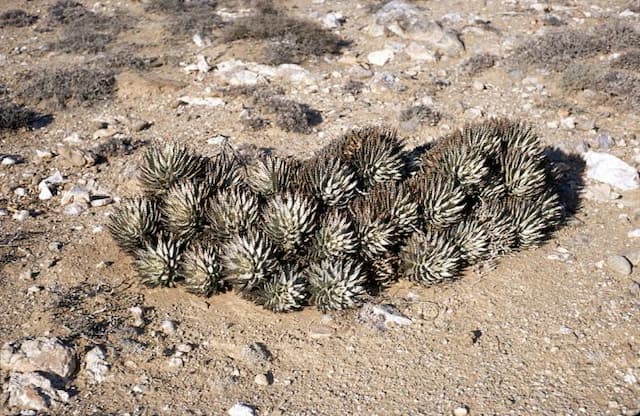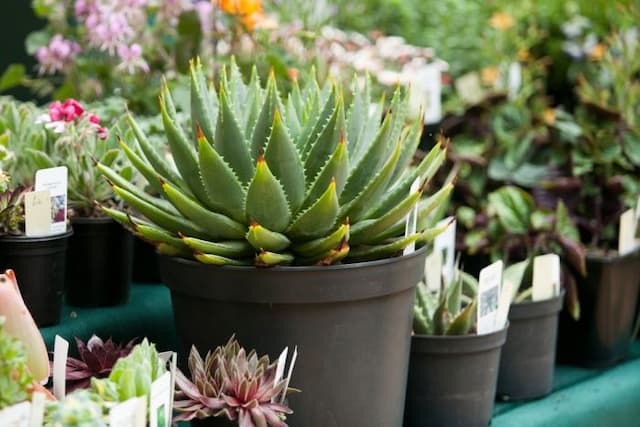Red Hot Poker Kniphofia sarmentosa

ABOUT
Kniphofia sarmentosa, commonly known as the Red Hot Poker or Torch Lily, is an eye-catching flowering perennial known for its distinctive inflorescences that rise above clumps of arching, grass-like foliage. The leaves form a dense tussock at the base of the plant, and they are often evergreen, persistently presenting their lively, green color throughout the year. The torch-like flower spikes are the most striking feature of this plant, vividly colored with a gradation of fiery hues. Starting from the bottom, the blooms range from rich reds and warm oranges to softer yellows toward the top, reminiscent of a flickering flame. The tubular flowers, tightly packed on the upright flower stalks, open from the bottom upwards, slowly revealing the full spectrum of warm colors over the flowering period, which usually occurs in the warmer months. The blooms not only provide a burst of color in garden settings but also attract a variety of pollinators, from hummingbirds to bees and butterflies, who are drawn by the nectar-rich flowers. With its distinctive coloration and hardy foliage, the Red Hot Poker makes a striking addition to a variety of garden landscapes where it adds a strong vertical element and a sense of vibrancy and drama.
About this plant
 Names
NamesFamily
Asphodelaceae
Synonyms
Red Hot Poker, Torch Lily, Poker Plant
Common names
Kniphofia aloides, Kniphofia alooides, Kniphofia uvaria var. flammea, Tritoma uvaria, Tritoma aloides, Aloe aloides.
 Toxicity
ToxicityTo humans
The Red Hot Poker (Kniphofia sarmentosa) is not commonly listed as a toxic plant to humans. However, as with many plants, it is always possible for individuals to have allergic reactions or sensitivities. Eating or handling plants can sometimes result in adverse reactions, so it is advisable, especially with unknown plants, to avoid ingestion and to wear gloves while handling. If Red Hot Poker were poisonous, symptoms could hypothetically range from mild (nausea, vomiting, and diarrhea) to severe (difficulty breathing, increased heart rate), depending on the nature and level of toxicity. Nevertheless, since it is not typically reported as toxic, symptoms from ingestion are unlikely to be severe unless there is an underlying allergy or specific sensitivity.
To pets
Red Hot Poker (Kniphofia sarmentosa) does not have a widespread reputation as a toxic plant for pets. Nonetheless, it is always best to prevent pets from ingesting plants. Some plants, even those not known for toxicity, can cause gastrointestinal upset such as vomiting or diarrhea in pets. If a pet does ingest part of a Red Hot Poker and reacts poorly, watching for signs of distress and contacting a veterinarian is recommended. In the absence of specific toxicity, severe symptoms such as significant digestive distress, lethargy, or neurological signs are not commonly expected from this plant.
 Characteristics
CharacteristicsLife cycle
Perennials
Foliage type
Evergreen
Color of leaves
Green
Flower color
Mixed
Height
2-3 feet (0.6-0.9 meters)
Spread
1-2 feet (0.3-0.6 meters)
Plant type
Herb
Hardiness zones
5
Native area
South Africa
Benefits
 General Benefits
General Benefits- Ornamental Value: Kniphofia sarmentosa, commonly known as Red Hot Poker, adds striking vertical accents and a splash of vibrant color to gardens with its tall spikes of reddish-orange flowers.
- Attracts Pollinators: The bright blooms are excellent for attracting hummingbirds, bees, and butterflies, contributing to pollination in the garden.
- Drought Tolerance: Once established, the Red Hot Poker is drought-resistant, making it ideal for xeriscaping and low-water-use landscapes.
- Low Maintenance: This plant requires minimal care, which is beneficial for gardeners looking for low-effort but high-impact plants.
- Deer Resistance: Kniphofia is not a preferred food source for deer, thus it is less likely to be damaged in areas with deer pressure.
- Versatility in Landscape Design: It's suitable for a range of garden designs, including borders, cutting gardens, and container planting.
- Seasonal Interest: Red Hot Poker has a long flowering period from late spring to summer, maintaining interest throughout the season.
- Durability: It can endure a range of soil conditions as long as there is good drainage, which means it can thrive in various garden situations.
 Medical Properties
Medical PropertiesThis plant is not used for medical purposes.
 Air-purifying Qualities
Air-purifying QualitiesThis plant is not specifically known for air purifying qualities.
 Other Uses
Other Uses- As a natural dye: The flowers of the Red Hot Poker can be used to produce a natural dye for fabric or wool, imparting a range of warm hues.
- Insect attraction: Red Hot Poker can be planted in gardens to attract pollinators such as bees and butterflies, supporting local ecosystems.
- Floral arrangements: The vibrant and long poker-like blooms are popular in cut flower arrangements for their unique shape and color.
- Garden design: Their striking appearance and vertical structure are used by gardeners to create focal points or to add height and texture to borders.
- Soil erosion control: Due to their clumping growth habit, Red Hot Poker plants can help in stabilizing soil on slopes or banks and preventing erosion.
- Educational tool: Botanical gardens and educational programs may use Red Hot Poker plants to teach about pollination and plant adaptation.
- Companion planting: They can be used in companion planting to benefit other plants by attracting beneficial insects or providing shade.
- Xeriscaping: These plants are suitable for dry, water-wise gardens as they are drought-tolerant once established.
- Cultural significance: In some cultures, the Red Hot Poker may be used in ceremonies or traditional practices for its bright, noticeable appearance.
- Photography subject: With their vivid flowers and structural form, Red Hot Poker plants are often chosen as subjects for photography and botanical illustration.
Interesting Facts
 Feng Shui
Feng ShuiThe plant Kniphofia, commonly known as Red Hot Poker, is not used in Feng Shui practice.
 Zodiac Sign Compitability
Zodiac Sign CompitabilityThe plant Red Hot Poker is not used in astrology practice.
 Plant Symbolism
Plant Symbolism- Attraction & Fascination: With its striking appearance and vibrant colors, Kniphofia, also known as Red Hot Poker, often symbolizes attraction and fascination. It grabs attention and represents being mesmerized by someone or something.
- Standing Out: The Red Hot Poker's distinct look can be a symbol for standing out in a crowd and being unique, celebrating individuality.
- Vibrance and Energy: The fiery red and orange hues of the Red Hot Poker convey vibrance and high energy, making it a symbol for vitality and action.
- Power & Strength: The bold and sturdy nature of the plant can be symbolic of power and strength, inspiring courage and confidence.
 Water
WaterThe Red Hot Poker (Kniphofia sarmentosa) prefers consistent moisture, especially during the growing season. It should be watered deeply once or twice a week, depending on the weather conditions. Ensure the soil is well-drained to prevent root rot. In absence of rainfall, provide about 1 gallon of water weekly. During the winter months, reduce the frequency as the plant enters a period of dormancy.
 Light
LightRed Hot Pokers thrive in full sun conditions, ideally receiving at least six hours of direct sunlight daily. Planting Kniphofia sarmentosa in a spot that is exposed to the morning sun and afternoon sun is ideal to ensure sufficient light for robust growth and vibrant bloom production.
 Temperature
TemperatureThe Red Hot Poker can tolerate a range of temperatures; however, it prefers temperatures between 50°F and 85°F for optimal growth. It can withstand short periods of frost, but extended exposure to temperatures below 20°F may damage the plant. Ideally, maintain conditions that avoid the extremes of hot and cold for the best health of Kniphofia sarmentosa.
 Pruning
PruningRed Hot Poker should be pruned to remove spent flower spikes, which encourages new blooms, and to maintain a tidy appearance. Pruning is best done in the spring or after flowering. Deadheading can be done as needed throughout the blooming period to keep the plant looking its best.
 Cleaning
CleaningAs needed
 Soil
SoilRed Hot Poker thrives in well-draining soil with a mixture of loam and sand, enriched with compost or well-rotted manure. The ideal pH for this plant is between 6.0 and 7.0. A mix of two parts loam, one part sand, and one part compost creates an optimal environment for healthy growth.
 Repotting
RepottingRed Hot Poker does not need to be repotted frequently; it is generally sufficient to divide and repot these perennials every 3-5 years to ensure they have adequate space to grow and to rejuvenate the soil.
 Humidity & Misting
Humidity & MistingRed Hot Poker is quite adaptable and does not require high humidity environments. Average ambient humidity is typically sufficient for this plant's growth.
 Suitable locations
Suitable locationsIndoor
Provide bright light, minimal water, and avoid overpotting Red Hot Poker.
Outdoor
Full sun, well-drained soil, and avoid waterlogged areas for Red Hot Poker.
Hardiness zone
5-9 USDA
 Life cycle
Life cycleThe life cycle of Kniphofia sarmentosa, commonly known as Red Hot Poker, begins with germination, where seeds sprout in warm, well-drained soil after the threat of frost has passed. In the seedling phase, the plants develop their first true leaves and gradually form a rosette. As the plant matures, it enters the vegetative stage, growing long, strap-like leaves and thickening at the base. The next stage is the flowering phase, where tall flowering spikes emerge, displaying tubular flowers usually ranging from yellow to red. After pollination, typically by birds or insects, the flowers develop into capsules containing numerous small seeds. Finally, the plant enters a period of dormancy during colder months, reducing its metabolic activity until the conditions are favorable for the next growth cycle.
 Propogation
PropogationPropogation time
Spring to summer
The most popular method of propagation for the Kniphofia sarmentosa, commonly known as the Red Hot Poker, is by division. The ideal time to propagate by division is in the spring. Red Hot Poker is a clump-forming perennial, and as the clumps enlarge, they can be lifted from the ground and carefully separated into smaller clumps. Each clump should have a good root system and several shoots. The divisions are then replanted into well-prepared soil, ensuring that they're spaced appropriately to allow for growth. It's important to water the new divisions well after planting to help establish them. This method is straightforward and usually results in robust, bloom-producing plants in the following growing season.









